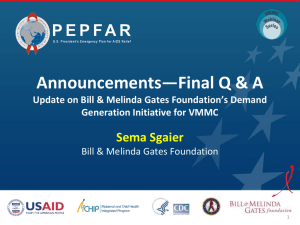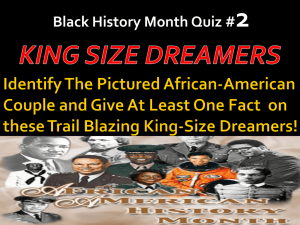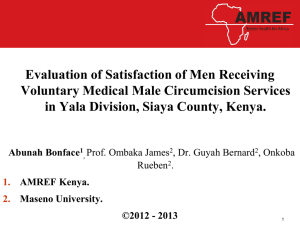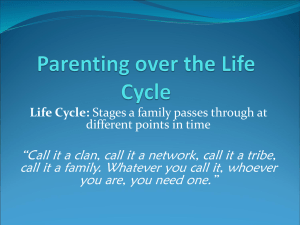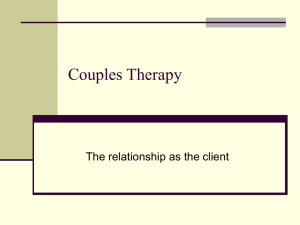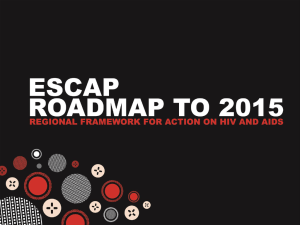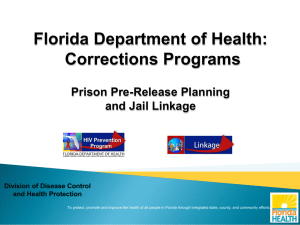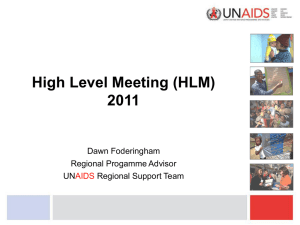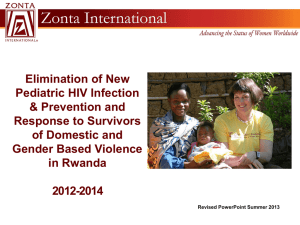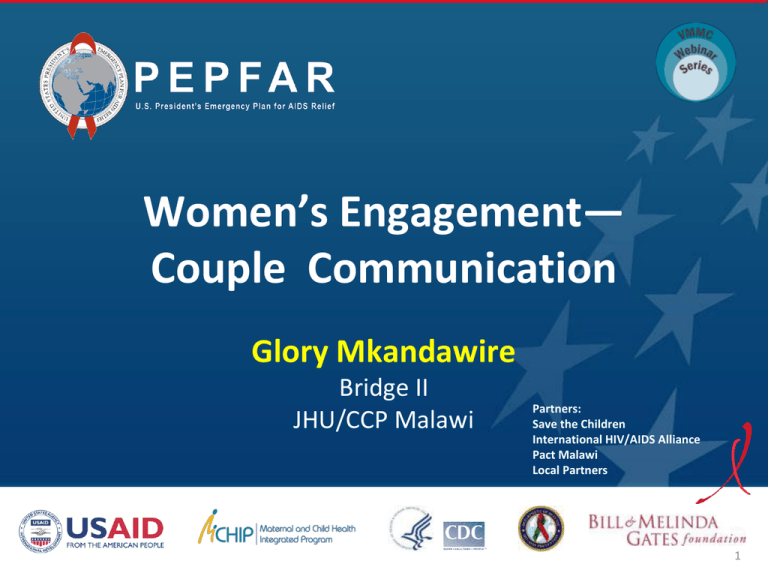
Women’s Engagement—
Couple Communication
Glory Mkandawire
Bridge II
JHU/CCP Malawi
Partners:
Save the Children
International HIV/AIDS Alliance
Pact Malawi
Local Partners
1
Background
• BRIDGE II formative research and literature review findings
showed:
– Lack of couple communication as a factor that makes men and women go outside
of marriage for sexual satisfaction
– Family value was an important element of influence on individual
behavior
– Partner reduction viewed as a good strategy toward HIV prevention
• BRIDGE II developed the “Tasankha” (We choose/Choices)
Mass Media Campaign to strengthen risk reduction,
individual/couple efficacy and collective efficacy
– First phase focused on strengthening risk reduction, individual/couple efficacy, and
collective efficacy.
– Building on first phase, second phase of the campaign focused on
linking people to services such as VMMC, PMTCT & HTC.
2
Strategic Approaches
• Creating an enabling environment at national level
through Tasankha (Choices) Campaign and Chenicheni
Nchiti? (What is the reality?) radio program
• Mobilizing communities to address HIV/AIDS issues
affecting their communities
• Building capacity of community structures to facilitate
engagement
• Creating dialogue among couples and communities
using transformative tools, community activities and
national forum
• Linking communities to various HIV prevention services
3
Approach: Couple Communication
• Starting local (community):
– Use local personal stories/diaries
• Making it global (radio) through:
– Reality radio
– National dialogue on couple communication
• Taking the global back to local (community discussions):
– Build capacity of local structures
– Use transformative tools
– Use community-wide events
• All reflect same issues as radio … while radio reflects community
voices
• Localizes the discussion to community level
• Addresses the importance of couple communication in making
decisions and choices around so many health issues
4
Approach: Women’s Engagement
• Women’s engagement is part of overall community
engagement.
• Community entry process following the Community Action
Cycle (CAC) to build partnerships with and capacity of
community structures, and ensure engagement and
ownership.
• Community Action Groups (CAGs)—members of communitybased organizations (CBOs)—lead process of identifying key
issues to be addressed.
• The whole community (men and women) then comes to an
agreement and prioritizes three key issues.
• CAGs develop plans to address the priorities.
5
How to Stimulate Open Dialogue:
Couple Communication
• In FBOs, couples trained as counselors lead discussions with a group of
couples or individual couples using the counseling guide.
• Community facilitators lead small group discussions using transformative
tools:
– Easier for women to take part in discussions in a small group.
– Real stories, games and role plays to stimulate discussion.
– Provides an avenue for women and men to talk openly.
• Community wide events (interactive drama, open days, discussion
forums):
– Provides a forum for sharing testimonials from real couples.
– Helps to openly address sensitive issues around infidelity.
– Traditional leaders lead the process through speeches and by being an
example.
• CBO networks support individual CBOs and Community Referral Agents
through supervision and monitoring.
6
Women’s Engagement, Couple
Communication and Linking to Services
• With women’s support and couple communication, men find it easier to
take advantage of voluntary medical male circumcision (VMMC) and other
services.
– Men find it easier to talk about VMMC with their partners.
– Men find support post VMMC from their partners.
– Women see the need to talk about VMMC because they also benefit—
reduced risk of cervical cancer.
• Community Referral Agents engage individuals and couples, and link them
to various services including VMMC, HIV testing and counseling (HTC),
prevention of mother-to-child transmission of HIV (PMTCT).
• Women’s engagement and couple communication help to increase
protection for couples who choose not to go for VMMC through:
– Joint decision-making, making positive choices
– Increased HTC uptake and access of risk reduction measures
– Increased protection among couples
7
Success Story
“Due to encouragement
from my wife, I went for
VMMC and now I can testify
publicly to my people that it
is very nice… and apart from
minimizing the risk of HIV
infection, it also add up to
sexual satisfaction.”
Traditional Authority Kaduya, Phalombe.
Success Stories
“I was afraid because people said the wound would not heal
because it’s one way of family planning. However, due to
encouragement from my wife, I decided to go for circumcision …
everything is alright now.” said Weston Maganga. And the wife
said “I decided to encourage my husband to minimize the risk of
cervical cancer because I fear it a lot” Enelesi Maganga.
Weston & Enelesi Maganga, Phalombe
Fibby Mwangala used to attend BRIDGE II VMMC demand creation
activities and always told her husband about the benefits of VMMC.
Last week on 31st May 2013 Fibby’s husband, John, went for VMMC
and had this to say: “meanwhile together with my wife we are
nursing our wound after check up and the support I am receiving
from my wife is overwhelming.”
Fibby and John Mwangala, Phalombe
Transformative Tools
•
Tasankha Discussion Guide:
– A modular, interactive and participatory guide that promotes
couple and community dialogue.
– Covers 10 topics including couple communication, multiple
concurrent partnerships (MCPs), PMTCT, HIV testing and VMMC.
– Uses small discussion groups of men and women.
•
A Happy Married Life:
– A guide for counselors and faith leaders working with married
couples in Christian and Muslim communities in the context of
HIV and AIDS.
– Covers topics such as couple communication, sex in marriage,
sex outside marriage, conflict resolution and management.
– Uses small discussion groups of couples.
10
Transformative Tools
• Planting Our Tree of Hope: A Toolkit on Positive
Prevention for People Living with HIV (PLHIV):
– Helps PLHIV develop interpersonal
communication skills to address issues, such as
discordance and protecting oneself and one’s
partner, and identify doable actions that will
help them, their partners and families to live
healthy and productive lives.
• African Transformation:
– Enables communities to explore how gender
norms and social roles shape the lives of men
and women.
– Adapted from Uganda, includes Malawian
profiles on MCP, VMMC, social roles, genderbased violence and intergeneration sex.
11
Research: Couple Communication
• BRIDGE II endline research to evaluate effects of couple
communication:
– Include questions that ask specifically about
communication with partner, topics discussed, frequency
and how couple communication affected their
relationship.
– Explore relationship between the above communication
variables to exposure to BRIDGE II including HIV preventive
behaviors such as multiple partnerships, condom use, HIV
testing and VMMC.
– Conduct mediation analysis to understand the role that
couple communication had on the relationship between
BRIDGE II exposure and HIV prevention behaviors.
12
Summary
• Women should be part of the larger community
engagement process to ensure women’s open
communication with their partners.
• Using real stories, and interactive and
participatory methodologies stimulate discussion
and help couples identify ways of addressing
difficult issues such as trust, fear of infidelity, etc.
• Women’s engagement and couple
communication help mutual decision-making and
linkage to various services including VMMC and
HTC.
13
Contact Information
Email:
gmkandawire@malawibridge.org
Phone numbers:
265 (0) 1 750 733
265 (0) 992 961 826
Thank You!
14
Acknowledgments
• PEPFAR for funding the project
• Implementing partners
• Collaborating partners
– Ministry of Health
– National AIDS Commission
15

